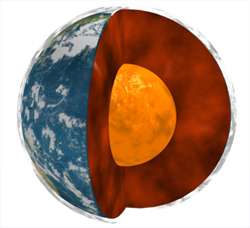New research could help scientists unravel some of the mysteries concerning the hot iron core of Earth. Image courtesy of NASA.
(PhysOrg.com) -- Conventional scientific wisdom says that the interatomic forces between ions that control high-temperature processes such as melting are insensitive to the heating of the electron "glue" that binds the ions together. In effect, traditional atomistic simulations ignore electron temperature completely.
However, in a recent Physical Review Letter, Lab physicists John Moriarty, Randolph Hood and Lin Yang show how electron temperature has a surprisingly large impact on phase stability and melting in refractory transition metals like molybdenum, where the binding d electrons form strong directional bonds.
The LLNL team has developed a new atomistic simulation capability to treat such effects quantum mechanically through temperature-dependent, multi-ion interatomic potentials that can be used in large-scale simulations of thermodynamic and mechanical properties of materials.
This capability could help scientists unravel phase-diagram mysteries concerning the hot iron core of the earth as well as help engineers design safer nuclear reactors.
In the past decade, high-pressure melting of transition metals and the possibility of undiscovered stable solid phases just below the melting temperature have been subjects of widespread scientific interest, as well as considerable controversy.
"The present advance not only sheds new light on such high-pressure phase-diagram issues, but it will also enable in-depth investigations of other important problems in high-temperature materials science," Moriarty said.
These problems include the design of improved high-temperature alloys for jet engines, the mitigation of stress-corrosion cracking in nuclear reactors, and the accurate modeling of ultra-fast laser-heating experiments performed on facilities like the National Ignition Facility (NIF), in which the electrons are rapidly heated far above the ion temperature, altering normal materials properties.
The research appears in the Jan. 20 edition of Physical Review Letters.
More information: prl.aps.org/pdf/PRL/v108/i3/e036401
Journal information: Physical Review Letters
Provided by Lawrence Livermore National Laboratory





















